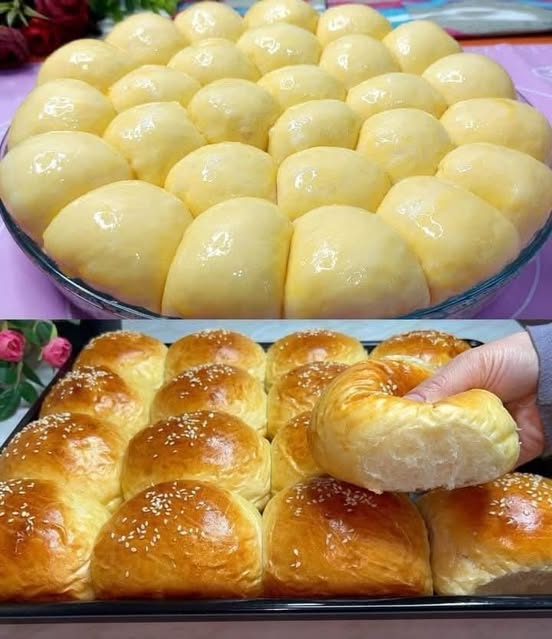Brioche is a classic French pastry that has captured the hearts of bakers and food lovers around the world. Known for its soft, pillowy texture and rich flavor, brioche is a versatile treat that can be enjoyed as a breakfast, dessert, or even as a side to savory dishes. The key to an irresistibly soft and fluffy brioche lies in the right combination of ingredients, careful preparation, and proper baking technique. In this detailed guide, we’ll walk you through the process of making the perfect milk brioche – a light, airy, and super soft bread that feels like a cloud in your mouth.
Ingredients for Milk Brioche
Here’s the list of ingredients you’ll need to make the fluffiest and softest milk brioche:
- 500ml (2 cups) warm milk: This will act as the liquid base to activate the yeast and ensure the dough is hydrated.
- 7g (1 1/2 tsp) dry yeast: Yeast is essential for leavening the dough, giving it that soft and fluffy texture.
- 100g (0.5 cup) brown sugar: The sugar adds sweetness to the brioche and also helps feed the yeast for proper fermentation.
- 60ml (0.3 cup) oil: This helps in creating a moist and tender crumb. You can use vegetable or sunflower oil.
- 1 tbsp vinegar: A small amount of vinegar helps balance the acidity in the dough, ensuring a better rise and softer texture.
- 1 tsp salt: Salt is necessary for flavor and it also helps to regulate the yeast activity.
- 2 eggs: Eggs contribute to the richness and softness of the brioche, making it tender and flavorful.
- 750g (6 cups) flour: A high-protein bread flour is the best choice for this recipe as it provides the necessary structure to hold the airy crumb.
- 50g (0.2 cup) butter: Butter adds flavor and richness to the brioche, contributing to its tender texture and golden color.
Step-by-Step Instructions to Make the Fluffiest Milk Brioche
Making milk brioche requires patience, but with the right steps, you can create a loaf that’s light as a cloud and incredibly soft. Let’s break it down:
Step 1: Prepare the Yeast Mixture
First, you need to activate the yeast to ensure it will do its job of leavening the dough.
- Warm the milk: In a small saucepan, heat 500ml of milk until it’s just warm to the touch, around 100-110°F (37-43°C). If it’s too hot, it may kill the yeast, so be sure to check the temperature before proceeding.
- Dissolve the sugar: Add 100g of brown sugar to the warm milk and stir until the sugar has dissolved. The sugar will provide food for the yeast and help it activate.
- Add the yeast: Sprinkle 7g of dry yeast over the surface of the milk mixture. Allow the yeast to sit undisturbed for 5 to 10 minutes until it becomes foamy and bubbly. This step is crucial, as it proves the yeast is alive and ready to work.
Step 2: Combine Wet Ingredients
While the yeast is blooming, you can prepare the rest of the wet ingredients.
- Mix the oil and vinegar: In a separate bowl, combine 60ml of oil with 1 tablespoon of vinegar. This combination helps the dough remain tender and enhances the rise.
- Add the eggs: Crack 2 eggs into the bowl with the oil and vinegar. Mix them together until smooth.
Step 3: Make the Dough
Now that the yeast is activated, you can begin forming the dough.
- Combine dry ingredients: In a large mixing bowl, sift together 750g of flour and 1 teaspoon of salt. This ensures that the flour is evenly distributed and removes any lumps.
- Add the wet ingredients: Make a well in the center of the flour mixture and pour in the activated yeast mixture along with the egg-oil-vinegar blend.
- Mix the dough: Using a spatula or your hands, start incorporating the flour into the wet ingredients. Once the dough begins to come together, transfer it onto a clean surface and knead.
- Knead the dough: Knead the dough for about 10 minutes. The dough should be slightly sticky, but it will become smooth and elastic as you work it. If the dough is too sticky, sprinkle a small amount of flour, but be careful not to add too much as it will affect the texture of the brioche.
Step 4: Incorporate Butter
The key to a tender, soft brioche is the butter, and it should be added after the dough has been kneaded into a smooth consistency.
- Add the butter: Cut 50g of butter into small cubes and add it to the dough. Knead the dough for another 5-7 minutes until the butter is fully incorporated and the dough is smooth and elastic. The butter will make the dough rich and moist, so don’t rush this step.
- Test the dough: To check if the dough is ready, do the “windowpane test.” Stretch a small piece of dough between your fingers. If it stretches without breaking and forms a thin, translucent membrane, the dough is ready.
Click page 2 for more




